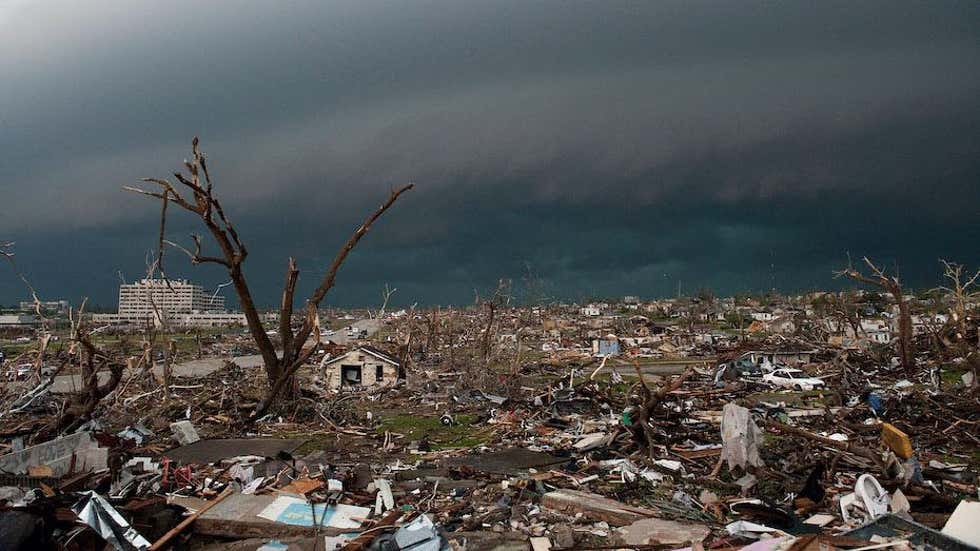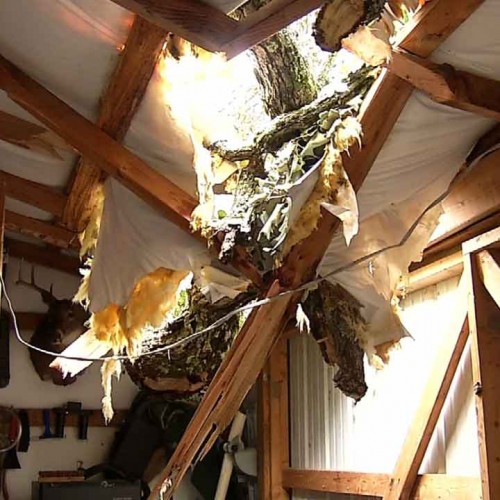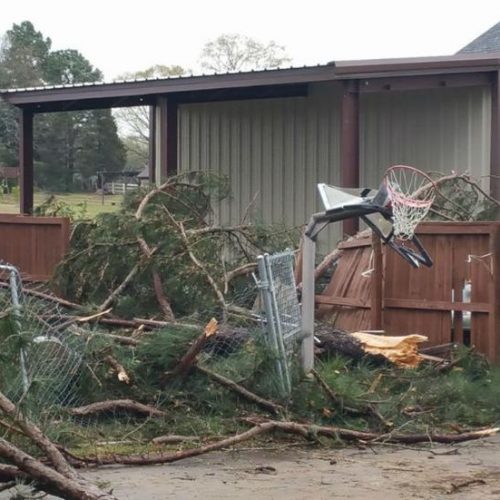Saturday marks the 10-year anniversary of the Joplin tornado, which tore a six-mile-long and up to a mile-wide path of devastation through the southwest Missouri city.
One hundred fifty-eight people lost their lives directly due to the EF5 tornado on May 22, 2011.
The city will commemorate the anniversary with an observance Saturday, including a tolling of bells and a minute of silence at the exact minute the tornado entered the city.
One of the nation’s worst single tornadoes lingers in the memory of meteorologists who covered it, from those who arrived at the scene to those who warned the public of the danger.
Here are some reflections from meteorologists of that tragic evening.
It Didn’t ‘Look Like a Tornado’ To Some
You might think a large, violent tornado would have an obvious, ominous appearance, like the May 1999 Moore-Oklahoma City or the April 27, 2011, Tuscaloosa, Alabama, tornadoes.
KSNF-TV’s tower camera captured the wedge tornado as it moved into Joplin. Power flashes occurred as the storm damaged electrical lines and equipment.
The National Weather Service in Springfield, Missouri, issued a tornado warning 17 minutes before the twister touched down on the city’s western edge.
Despite the lead time provided by the warning, it may not have been apparent to those in its path that a tornado was approaching. It was wrapped in heavy rain and difficult to recognize as a tornado from the ground.
A number of thunderstorm cells merged before and while the tornado was occurring. This added rain to the tornado-producing thunderstorm as it intensified and entered the city, as seen in the radar history below.
These so-called high-precipitation supercells are notorious for hiding tornadoes within curtains of rain.
Horrific Death Toll in the Doppler Era
It seemed improbable in the era of Doppler radar, the internet, spotter networks, watches and warnings and news media that a single tornado could claim over 100 lives in the U.S.
Then came the April 2011 Super Outbreak, when some 350 tornadoes killed over 300 people in the South.
Less than a month later, Joplin shattered the notion that modern technology could guard against a prolific death toll from a single tornado.
Officially, 158 deaths were directly attributed to the tornado, the seventh-deadliest single tornado in the U.S. according to NOAA’s Storm Prediction Center. It was the deadliest tornado since 1947, which was before tornado warnings were routinely issued.
A report by the National Institute of Standards and Technology found that 87% of the fatalities occurred inside a building.
NIST also found that 82% of Joplin homes lacked basements, but that no deaths occurred in damaged homes where people sought shelter in basements.
“Merely seeking shelter in the lowest, innermost portion of a home adds a measure of safety, but does not guarantee survival,” Greg Forbes, former severe weather expert at The Weather Channel, told weather.com in an email.
Forbes said Joplin illustrates the need for underground and specially designed in-home tornado shelters.
“Warnings aren’t enough when it comes to violent tornadoes. Homes are no match for a violent tornado,” he said.
Arriving at a Devastated Hospital
Mike Bettes of The Weather Channel arrived in Joplin moments after the tornado.
After he searched damaged vehicles for survivors, Bettes reported live from the scene near the devastated St. John’s Regional Medical Center. The sight brought the experienced meteorologist to tears.
“We watched as firefighters used nothing more than their bare hands to rescue people trapped under the weight of their own homes. We watched as victim after victim was pulled from the debris, each with a grieving family member,” Bettes wrote in a 2012 piece for weather.com.
Bettes said there was one image that remains in his memory.
“A man walked up to me, soaking wet and dirty from head to toe. He was dazed and a little panicked. He had a muddy towel over his hand. He asked me if I could help him. I asked him what was wrong. He said nothing. He just removed the towel from his hand. He had a very large gash and was in need of immediate medical attention. I couldn’t do anything for him. All I could do was tell him to keep walking toward an area where some doctors and nurses had gathered.”
Jessica Baker, a weather.com content manager at the time, also arrived at St. John’s Regional Medical Center immediately after the tornado.
“As we got closer to the hospital, the situation dramatically changed. The hospital was smoking – smoking!” Baker said.
“We saw parents carrying kids on their shoulders, trying to figure out where to go and what to do next. I remember looking to my right and thinking, ‘There’s a field,’ only for it to dawn on me moments later that it used to be a subdivision.”
St. John’s Regional Medical Center was too unsafe to rebuild and had to be demolished in January 2012.
According to NIST, 12 impact-related deaths occurred in the hospital, four involving patients in intensive-care units.
Mercy Hospital Joplin, built to withstand winds from an EF3 tornado, opened in March 2015.
The Scope of Devastation
The EF5 tornado that tore through the heart of the city of about 50,000 left a damage scar that was difficult to put into context even by the most experienced meteorologists.
John Gagan, science and operations officer at the NWS office near Milwaukee, was a forecaster at the Springfield, Missouri, NWS office at the time of the tornado and toured the damage path a week later.
Gagan told weather.com the scope of the damage is what he remembers most.
“We essentially followed the center of the track and the damage was as far as the eye could see,” he said. “I remember the lack of landmarks and road signs. Road names were spray-painted in orange on the blacktop. No structure was untouched.”
The Joplin tornado remains the costliest single tornado in modern U.S. history, with damage estimated at $3.18 billion (adjusted for inflation to 2019).
According to the NIST report, 553 businesses and 7,411 homes were damaged or destroyed, affecting than more than 17,000 residents.
The tornado’s destruction produced about 4.1 million cubic yards of residential and commercial debris, according to “32 Minutes in May,” a book published by the Joplin Globe.
The ferocity of the damage also sticks with Gagan.
“The western half to two-thirds of the track featured defoliated and debarked trees, scouring, parking blocks scraped from the ground with the rebar and deposited well away from parking lots, a lot of debris loading as it progressed,” he said.
Manhole covers were lifted from a street and large steel support beams were curved, twisted or otherwise distorted.
This prompted the NWS to rate the Joplin tornado an EF5, despite an engineering study released two years later that failed to find any EF5 damage.
Gagan said it was the first, and hopefully only, EF5-rated tornado damage he’ll see in person.
Vehicles Unrecognizable, Tossed or Never Found
It’s the photos of deformed cars and trucks that I’ll never forget.
In the photo above from St. John’s Regional Medical Center, a damaged car landed on top of a building adjacent to the hospital. In the photo below, a truck’s back end was essentially shredded and what was left of it wrapped around a debarked tree.
Over 15,000 vehicles, including buses, vans and semi trucks, were tossed up to several blocks away and either crushed, rolled into balls or wrapped around trees beyond recognition.
Some owners never found their vehicles.
Joplin High School Graduation
Joplin High School was also heavily damaged by the tornado. Nobody was at the school at the time.
About three miles northeast of the high school, ceremonies for the 445 graduates had just ended at Missouri Southern State University.
Some at the ceremony were discussing the tornado warning. Sirens sounded before some of the graduates left the MSSU campus.
Leaving the ceremony, attendees then had to scramble for cover. One went to a nearby Home Depot, where at least seven people were killed.
Another graduate was sucked through the sunroof of his family’s SUV as they drove home. His body was found five days later in a pond.
A new Joplin High School campus opened on Sept. 2, 2014.
It Started as an Upper Midwest Outbreak
There was another deadly tornado on May 22, 2011, but it wasn’t anywhere near southwestern Missouri.
NOAA’s Storm Prediction Center issued a “moderate risk” for severe thunderstorms, its second-highest level in their daily severe outlooks, from Oklahoma to Wisconsin.
However, its highest tornado probabilities were in the upper Mississippi Valley. That’s where the day’s outbreak started.
An EF1 tornado tore through the west and north sides of the Minneapolis metro that afternoon. One person was killed along the tornado’s six-mile path through north Minneapolis, St. Louis Park, Golden Valley, Fridley, Mounds View and Blaine.
Another tornado, an EF2, crossed the Mississippi River and carved through the south side of La Crosse, Wisconsin.
In all, 48 tornadoes were documented that day.
But the deadly, destructive Joplin tornado overshadowed the rest.
More Outbreaks Followed
There was no break in the weather after one of the worst tornadoes in U.S. history.
A band of torrential rain just south of Joplin on the night of May 22 prompted a release of water from Table Rock Dam into the White River. The city was then soaked by almost two inches of rain next day. Hail-producing thunderstorms occurred west of Joplin, near the Kansas state line.
An outbreak of 186 tornadoes May 24-26, 2011, occurred primarily from the Plains to the Ohio Valley.
Most notable among these was another EF5 tornado that tore a 75-mile path across central Oklahoma to the west, northwest and north of Oklahoma City.
by Jonathan Erdman (2021, May 19) weather.com




